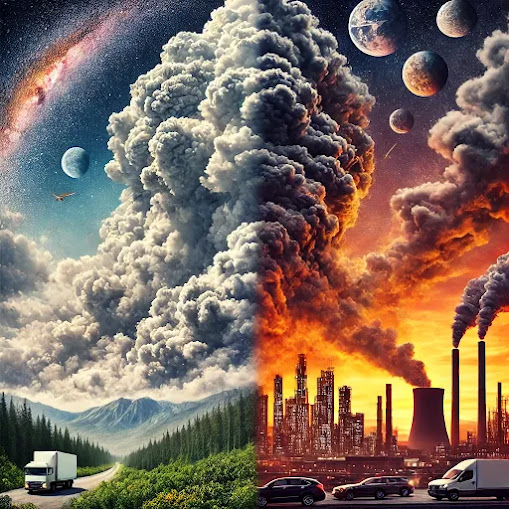Man-Made Poisons in the Atmosphere: Causes, Effects & Solutions
Human activity has introduced numerous harmful substances into the atmosphere, causing significant environmental and health concerns. From greenhouse gases to toxic particulates, these pollutants contribute to climate change, acid rain, and respiratory diseases. Understanding these emissions and their impact is the first step toward sustainable solutions.
 |
| Explore the impact of natural and man-made air pollutants, from volcanic ash and wildfire smoke to factory emissions, vehicle exhaust, and chemical smog. |
Major Man-Made Air Pollutants
1. Carbon Dioxide (CO₂) – The Leading Greenhouse Gas
- Sources: Fossil fuel combustion, deforestation, industrial processes
- Effects: Traps heat in the atmosphere, leading to global warming
- Solution: Shift to renewable energy, reforestation, energy efficiency
2. Methane (CH₄) – A Potent Heat-Trapper
- Sources: Livestock farming, landfills, oil and gas leaks
- Effects: More effective at trapping heat than CO₂, worsens climate change
- Solution: Improve waste management, reduce meat consumption, fix gas leaks
3. Nitrogen Oxides (NOₓ) – Smog and Acid Rain Contributors
- Sources: Vehicle exhaust, power plants, industrial emissions
- Effects: Forms smog, worsens asthma, contributes to acid rain
- Solution: Use cleaner fuels, electric vehicles, and stricter emission controls
4. Sulfur Dioxide (SO₂) – The Cause of Acid Rain
- Sources: Coal and oil burning, industrial processes
- Effects: Creates acid rain, damages ecosystems, harms lung health
- Solution: Switch to low-sulfur fuels, invest in emission scrubbing technology
5. Chlorofluorocarbons (CFCs) – Ozone Destroyers
- Sources: Refrigerants, aerosol sprays, foam-blowing agents
- Effects: Depletes the ozone layer, increasing UV radiation exposure
- Solution: Use eco-friendly refrigerants, enforce CFC bans
6. Particulate Matter (PM2.5 & PM10) – Tiny but Deadly
- Sources: Burning fuels, industrial activities, construction dust
- Effects: Causes lung disease, heart conditions, and reduced visibility
- Solution: Promote cleaner industry practices, reduce wood-burning stoves
7. Volatile Organic Compounds (VOCs) – Invisible but Harmful
- Sources: Paints, solvents, gasoline fumes
- Effects: Forms ground-level ozone, contributes to respiratory issues
- Solution: Use low-VOC products, improve ventilation, regulate emissions
8. Heavy Metals (Lead, Mercury, Cadmium) – Toxic Accumulators
- Sources: Industrial waste, mining, vehicle emissions
- Effects: Causes neurological damage, contaminates soil and water
- Solution: Regulate industrial emissions, promote safer disposal methods
The Impact of Air Pollution
Man-made air pollution contributes to:
- Climate Change: Greenhouse gases trap heat, causing rising temperatures and extreme weather.
- Health Risks: Airborne toxins increase respiratory diseases, heart conditions, and even cancer.
- Ecosystem Damage: Acid rain harms forests, bodies of water, and soil quality.
How to Reduce Air Pollution
- Switch to Clean Energy: Solar, wind, and hydropower reduce carbon emissions.
- Improve Transportation: Use public transit, electric vehicles, or carpooling.
- Support Sustainable Agriculture: Reduce methane from livestock and promote plant-based diets.
- Enforce Stronger Regulations: Advocate for policies that limit industrial pollution.
- Adopt Sustainable Lifestyles: Reduce waste, recycle, and use energy-efficient appliances.
Conclusion
Man-made atmospheric pollution poses a severe threat to both human health and the environment. By understanding its sources and effects, we can take action to reduce emissions and promote sustainable solutions. Every small step—choosing eco-friendly products, conserving energy, and advocating for cleaner policies—can make a difference in preserving our planet for future generations.









Comments
Post a Comment